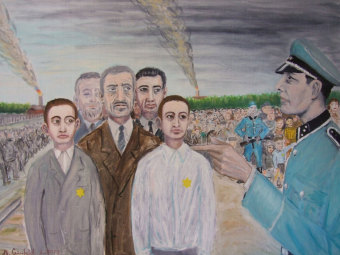Arrival in the Buna/Monowitz Concentration Camp

© Benjamin Grünfeld
From spring 1942 to May 1944, the deportation trains carrying Jews from all over Europe stopped at the “Old Ramp” at the Auschwitz freight station; after that date they stopped at the ramp in Birkenau, in some cases even in the open countryside. Upon arrival, the deportees were forced out of the cars by the SS, often with shouts and beatings. Also compelled to help with this process were prisoners from the “Canada work detachment,” who later had to gather up the arrivals’ abandoned baggage. (In the case of only a few transports were those selected for forced labor brought into the Buna/Monowitz concentration camp along with their suitcases.) The initial selection by SS officers, as of March 1943 the exclusive responsibility of SS doctors, took place right next to the train. Only those who were “fit for work” were picked for forced labor in Auschwitz and its numerous subcamps, including the Buna/Monowitz concentration camp. Children under 16, women with children, and the elderly were immediately sent to be killed in the gas chambers. Often they were taken away in trucks. Because they were told that these trucks were taking the feeble away to recuperate, other people who felt weakened after the deportation in the cattle car sometimes climbed aboard the trucks as well. About 70 to 80 percent of those reaching Auschwitz were sent directly to be gassed.
The rest were sent on foot or in trucks to the quarantine blocks of the main camp and Birkenau or directly to the quarantine blocks of the Buna/Monowitz concentration camp. There they had to give up all their valuables and their clothing, went to the “delousing” facilities, and were led into cold showers. The heads and entire bodies of the prisoners were shaved. Sometimes this procedure took hours. The new arrivals frequently learned as early as this point from the inmates that their relatives, from whom they had been separated so suddenly, had been murdered in Birkenau.
After the shaving, the new arrivals, still naked, were sent to the clothing office, where they received a set of prisoner clothing: trousers and a jacket made of blue-and-white striped cotton canvas, a shirt, a pair of underpants, a cap, and, as a rule, wooden shoes. Then the prisoners, under SS supervision, were registered, and a prisoner number was tattooed on the left forearm of “non-Aryan” prisoners. In the Buna/Monowitz concentration camp, each inmate received two pieces of cloth with a number and a triangle, which he had to sew on the jacket at chest level and on the upper right leg of the pants. The new arrivals found themselves robbed of their individuality in an environment that was incomprehensible to them. The arrival and the abrupt separation from their relatives must have left them in a state of shock. The sight of the emaciated prisoners in the lanes of the camp must have quickly made it clear to them what fate was intended for them as well.
During the numerous typhus epidemics in Auschwitz, the newly arrived prisoners were not taken to the Buna/Monowitz concentration camp at once. As a quarantine measure, there was a delay of several days in bringing them from the main camp or Birkenau to the Buna/Monowitz concentration camp, where they again were “deloused” and registered. The next day they were assigned to work details at the construction site of I.G. Farben. If prisoners were “transferred” directly to the Buna/Monowitz concentration camp, the SS isolated them for several weeks in their work assignments at the concentration site. From the winter of 1942/43 on, this quarantine measure could last up to six weeks. Prisoners from many transports, however, also were used at the construction site on the very day after their arrival. Owing to the large workforce requirement of I.G. Auschwitz, the SS frequently took all the men from a big transport who were “fit for work” and sent them in a body to the Buna/Monowitz concentration camp for forced labor.
Right in the beginning, in October and November 1942, groups of men “fit for work” from other concentration camps, primarily from Buchenwald, Sachsenhausen, and Dachau, also were “transferred” in a body to the Buna/Monowitz concentration camp to erect the camp. Over the course of 1944, in addition to the transports from all of Europe, groups of Jewish forced laborers from other forced labor camps in Poland were taken to Auschwitz. In some cases, these men had already been compelled to perform years of forced labor in camps such as those in Ostrowiec or in Szebnie before the advance of the Red Army made it necessary to “evacuate” them to Auschwitz, located farther to the west, for more forced labor. They came directly to the Buna/Monowitz concentration camp for registration, having been separated from their relatives long before.
(MN; transl. KL)
















